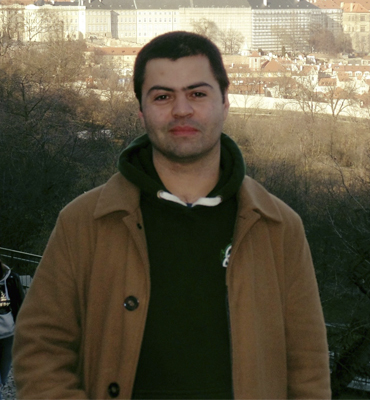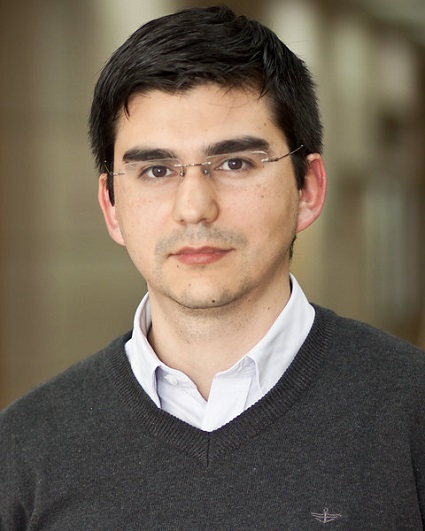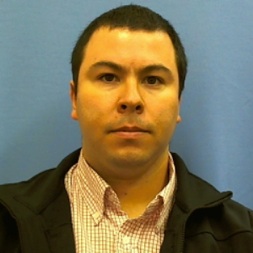COLLABORATORS
Ignacio Araya
PhD in Astrophysics, Universidad de Valparaíso, Valparaíso, Chile.
Assistant professor at Centro de Investigación DAiTA Lab, Universidad Mayor.
Email: ignacio.araya@umayor.cl
Publications: See Publications
Master thesis link: Repository
Research: Massive stars, stellar winds, hydrodynamics, radiative transport, numerical optimization
My primary research goals are focused on massive stars, mainly in their strong stellar winds. I use hydrodynamic codes and radiative transfer codes to model the available observational data of these stars. Also, I have worked on numerical optimization for orbital parameters of binary systems using a genetic algorithm.
Projects in execution:
- CoI: “Winds from massive stars in spherical and oblate geometries ” Fondecyt regular Nº1230131, 2023-2027
Past recent projects:
- PI: “Physical Parameters of Massive Stars” Fondecyt Iniciación Nº11190147, 2019-2022
- CoI: “Stellar winds in massive stars” Fondecyt Regular Nº 1190485, 2019-2023

Alex Gormaz Matamala
PhD in Astrophysics, Universidad de Valparaíso, Valparaíso, Chile.
Postdoctoral research at Nicolaus Copernicus Astronomical Center, Warsaw, Poland.
Email: agormazm@gmail.com
Publications: See Publications
PhD Thesis
- Evolution of Line-Force Multiplier Parameters in Radiation Driven Winds of Massive Stars
Gormaz Matamala, Alex Camilo.
2020, arXiv 2002, 07580G
https://ui.adsabs.harvard.edu/abs/2020arXiv200207580G
Master Thesis
- Spectroscopic Analysis of the Wolf-Rayet Star WR6 (HD50896): Searching the Origin of the Variability in its Wind
Gormaz Matamala, Alex Camilo.
2015, http://repositorio.udec.cl/jspui/handle/11594/1821 (in Spanish)
Research: Line-driven winds, mass-loss, radiative transfer, synthetic spectra, evolution of massive stars.
My research is focused on the calculation of theoretical values for the wind parameters of hot massive stars (spectral type O), being mass-loss rate the most important one.
For that purpose, we look for solutions of theoretical equations describing the acceleration of the wind, consistently with hydrodynamic code Hydwind (performed by Prof. Michel Curé) in order to predict these wind parameters. In an attempt to unify all element, the theory of line-driven winds for massive stars, we currently study the impact of the small-scale inhomogeneities (the so-called clumping) over the resulting line-acceleration. This study is being done using the radiative transfer CMFGEN. Theoretical mass-loss rates calculated by us are being used to fit synthetic spectra with the code FASTWIND, reducing the number of free parameters. Besides, these new mass-loss rates are necessary to perform new evolutive tracks using the Geneva-evolutive-code (GENEC).
Projects in execution:
- Associated researcher: Physics of Extreme Massive Stars, MSCA-RISE 823734, 2018-2022

Raquel Pezoa
Ph.D. in Informatics Engineering.
Universidad Técnica Federico Santa María (UTFSM), Valparaíso, Chile.
Profesor Adjunto, Escuela de Ingeniería Informática, Universidad de Valparaíso.
Associate Researcher CCTVal UTFSM.
Email: raquel.pezoa@usm.cl
Publications: See Publications
Research: Machine learning, high energy physics and astronomy data analysis, biomedical image processing
Projects in execution:
- PI: «A systematic study of the class imbalance problem in deep learning for classification of High Energy Physics data», Postdoc Proj. 3190740
- CoI: Proyecto InES Género UV: «Transformando la cultura de I+D+i+e de la Universidad de Valparaíso desde la equidad de género y el respeto por la diversidad».

Gonzalo Farias Castro
Ph.D. in control engineering, National University of Distance Education, Temuco, Chile.
PhD. in computer science, Complutense University of Madrid (UCM), Madrid, Spain.
Director Escuela de Ingeniería Eléctrica, Pontificia Universidad Católica de Valparaíso.
Associate Researcher CCTVal UTFSM.
Email: gonzalo.garias@pucv.cl
Research: Machine learning, pattern recognition, simulation and control of dynamic systems, and engineering education.
GONZALO FARIAS received the degree in computer science from the Universidad de la Frontera, Temuco, Chile, in 2001, the Ph.D. degree in control engineering from the National University of Distance Education (UNED), in 2010, and the Ph.D. degree in computer science from the Complutense University of Madrid (UCM), Madrid, Spain, in 2013. Since 2012, he has been with the Electrical Engineering School, Pontificia Universidad Católica de Valparaíso (PUCV). His current research interests include machine learning, pattern recognition, simulation and control of dynamic systems, and engineering education.

Pedro Escárate
Dr. in Electrical Engineering, Pontificia Universidad Católica de Chile.
M.Sc in Electrical Engineering, Pontificia Universidad Católica de Chile, Chile.
Profesor Asociado, Pontificia Universidad Católica de Valparaíso.
Email: pedro.escarate@pucv.cl
Publications: See Publications
Research: Electro-optics systems, Spectroscopy, Machine learning, system identification, adaptive optics

Massinissa Hadjara
PhD. in Astrophysics, University/Observatory of Côte d’Azur, Nice, France.
Research Scientist at Nanjing institute of Astronomical optics & Technology/Universidad de Chile.
Email: mhadjara@niaot.ac.cn mhadjara@ing.uchile.cl
Publications: See Publications
PhD thesis:
- Observations et modélisations spectro-interférometriques longue base des étoiles et de leur environnement proche, Hadjara, M.
- https://ui.adsabs.harvard.edu/abs/2017arXiv170907334H/abstract
Master Thesis:
- Etude et mise en oeuvre des techniques Temps-Distance en Heliosismologie, Hadjara, M.
- https://ui.adsabs.harvard.edu/abs/2017arXiv170907074H/abstract
Research: High Angular Resolution, Spectro-Interferometry, Hot Active Stars, Fast Rotators, Evolved Stars, Instrumentation, Heterodyne, Fringe Tracking.

Ronaldo Levengahen
PhD. in Astronomy, University of Sao Paulo, Brazil.
Associate Professor, Physics Department, Federal University of Sao Paulo (Unifesp) campus Diadema.
Email: ronaldo.levenhagen@unifesp.br
Publications: See Publications
Research: B/Be stars, Fast rotation, Circumstellar disks, Spectral synthesis, Gravity-Darkening, Radiative transport.

Sara Cuéllar
PhD in Electrical Engineering, Pontificia Universidad Católica de Valparaíso (PUCV), Chile.
Postdoctoral researcher at Centro Multidisciplinario de Física, Universidad Mayor, Chile.
Email: sara.cuellar@umayor.cl
Publications: See Publications
Research: Machine learning in astrophysics, Anomaly detection, Time-series analysis.

Elisson de Almeida
PhD in Sciences de la Planète et de l’Univers, Observatoire de la Côte d’Azur (Université Côte d’Azur), France.
Researcher at Observatorio Nacional, Rio de Janeiro, Brazil.
Email: elissonsgalmeida@gmail.com
Publications: See Publications
Research: Massive stars, stellar winds

